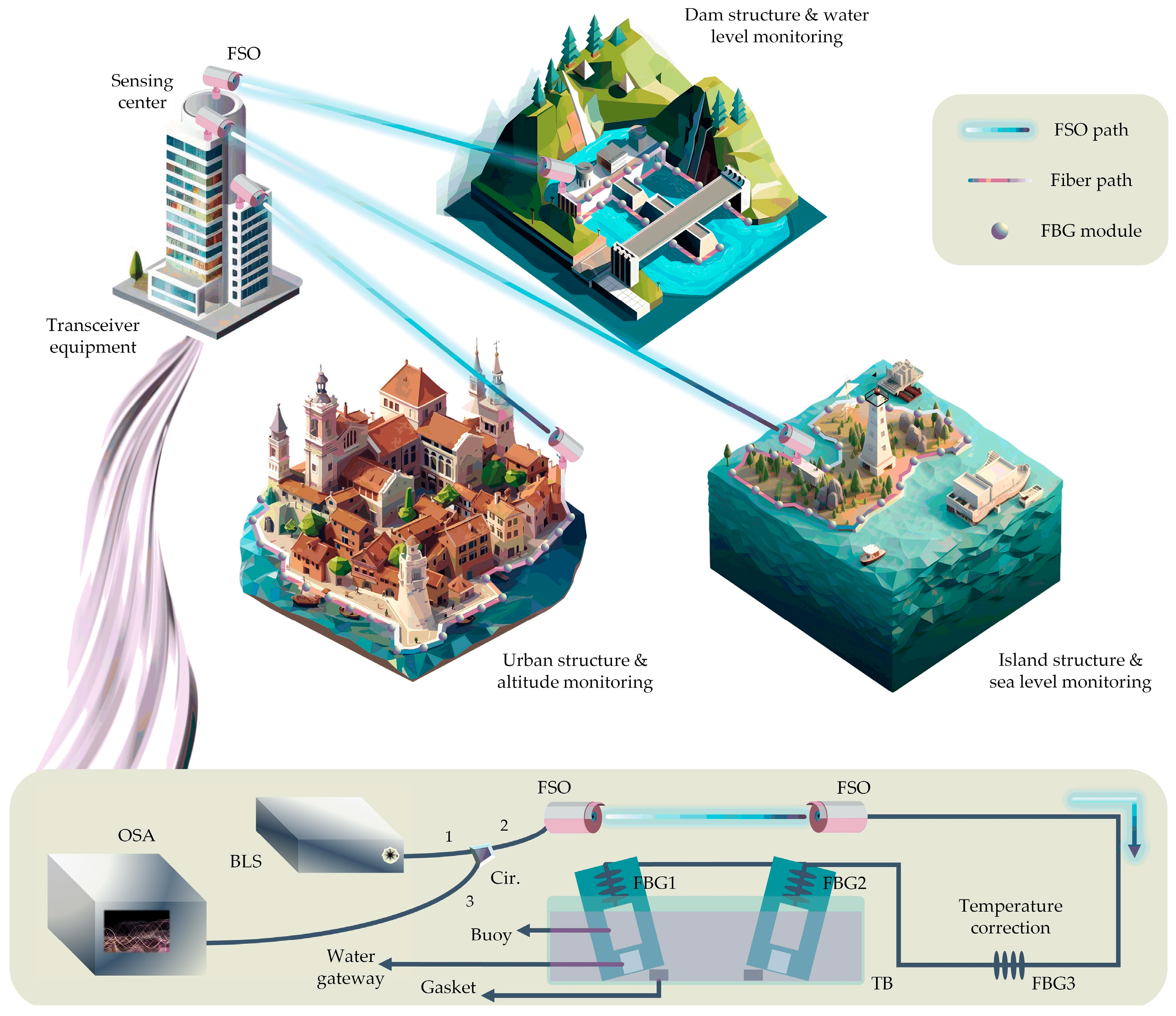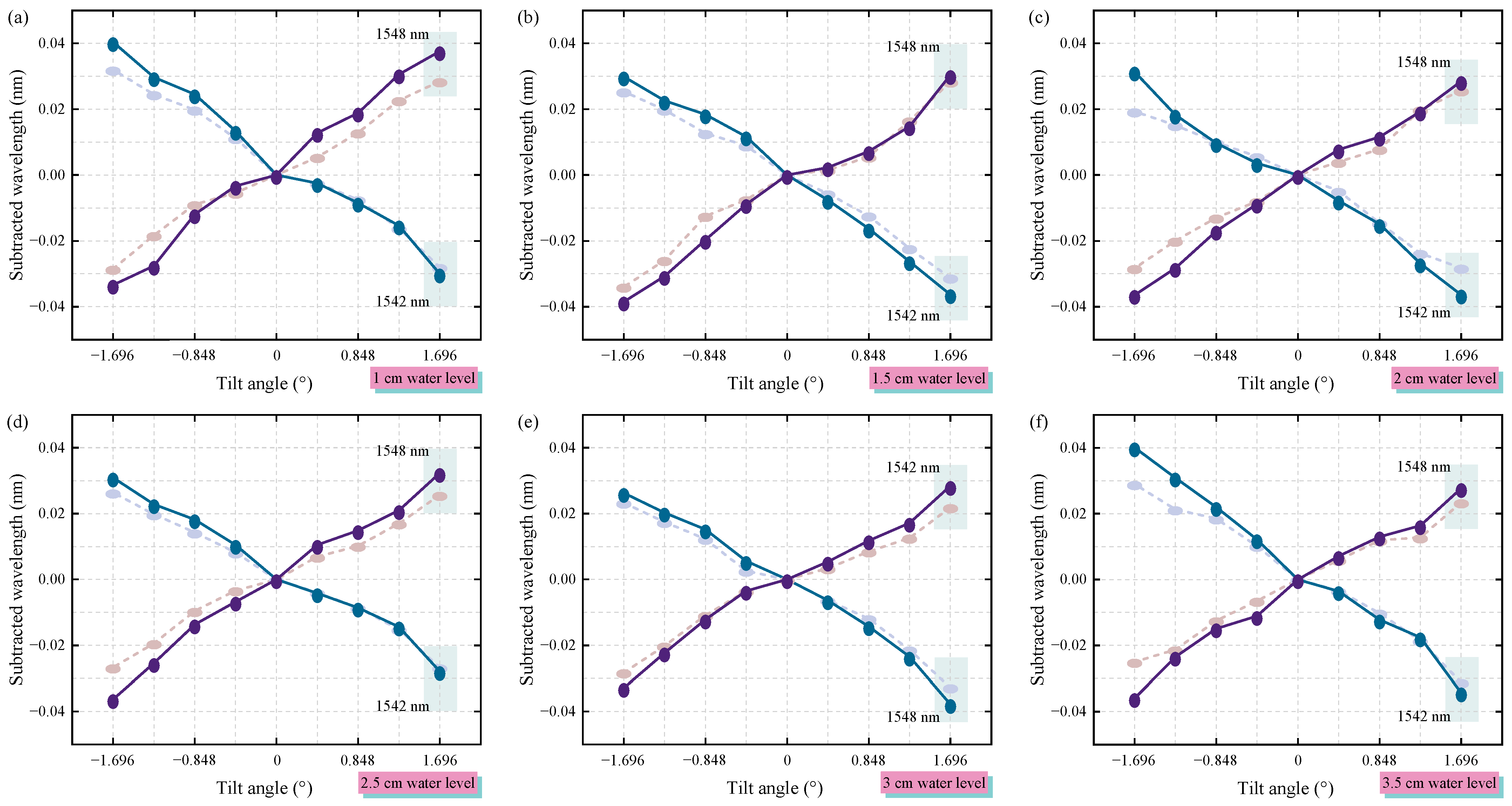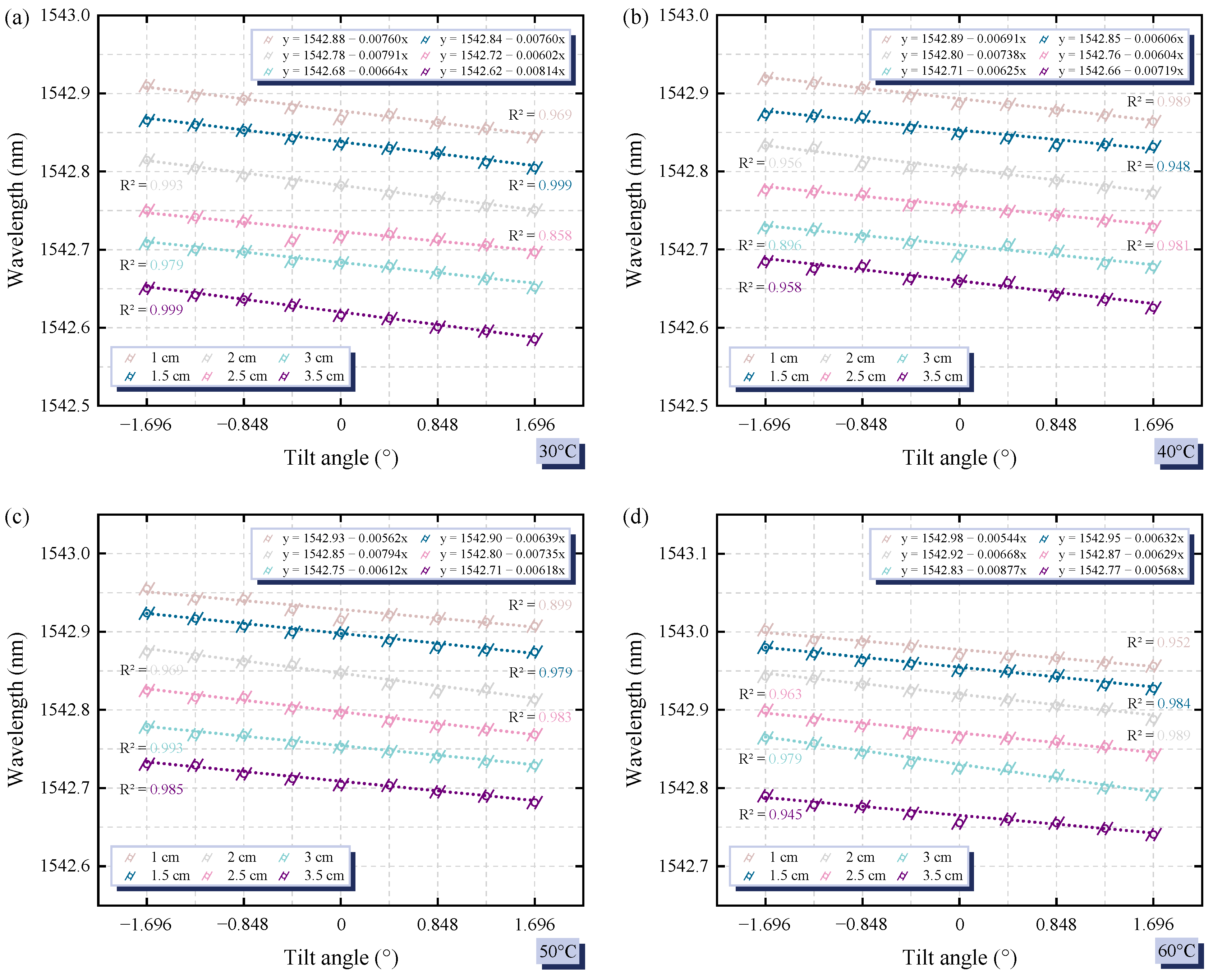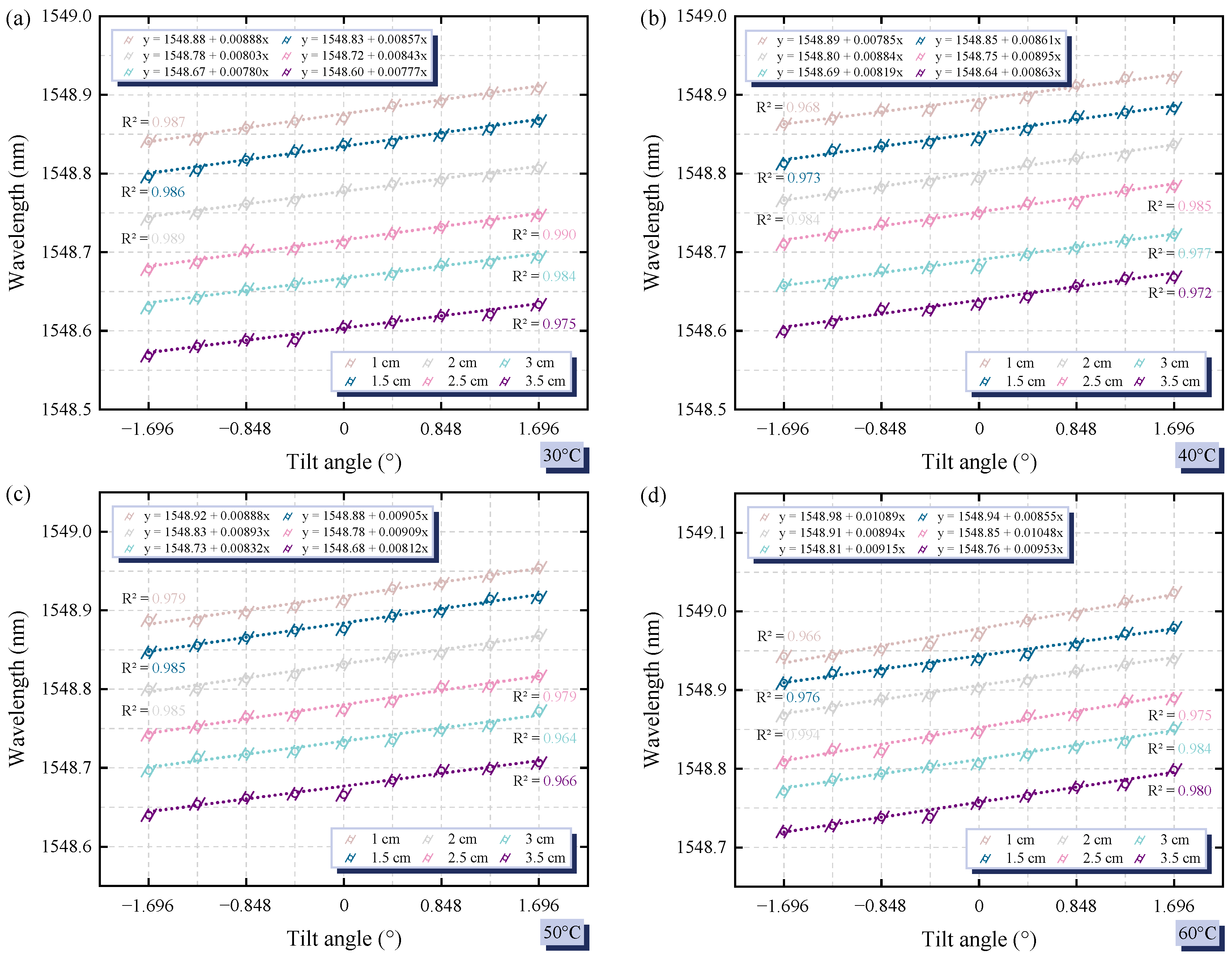Novel Fiber Bragg Grating Sensing Structure for Simultaneous Measurement of Inclination and Water Level
Abstract
1. Introduction
2. Experimental Setup
3. Experimental Results
4. Conclusions
Author Contributions
Funding
Institutional Review Board Statement
Informed Consent Statement
Data Availability Statement
Conflicts of Interest
References
- Song, J.; Leng, J.; Li, J.; Wei, H.; Li, S.; Wang, F. Application of Acoustic Emission Technique in Landslide Monitoring and Early Warning: A Review. Appl. Sci. 2025, 15, 1663. [Google Scholar] [CrossRef]
- Leal-Junior, A.; Silva, J.; Macedo, L.; Marchesi, A.; Morau, S.; Valentino, J.; Valentim, F.; Costa, M. The Role of Optical Fiber Sensors in the New Generation of Healthcare Devices: A Review. Sens. Diagn. 2024, 3, 1135–1158. [Google Scholar] [CrossRef]
- Cięszczyk, S.; Panas, P.; Skorupski, K.; Kida, M. Fibre Bragg Grating Wavelength Shift Demodulation with Filtering and Enhancement of Spectra by Simple Nonlinear Signal Processing. Appl. Sci. 2025, 15, 3384. [Google Scholar] [CrossRef]
- Leal-Junior, A.; Silveira, M.; Macedo, L.; Frizera, A.; Marques, C. Polarization-Assisted Multiparameter Sensing Using a Single Fiber Bragg Grating. Opt. Fiber Technol. 2024, 84, 103775. [Google Scholar] [CrossRef]
- Mandal, H.N.; Sidhishwari, S. Apodized Chirped Fiber Bragg Grating for Measuring the Uniform and Non-Uniform CharacTeristics of Physical Parameters. Measurement 2025, 240, 115606. [Google Scholar] [CrossRef]
- Ramos, C.C.; Preizal, J.; Hu, X.; Caucheteur, C.; Woyessa, G.; Bang, O.; Rocha, A.M.; Oliveira, R. High Resolution Liquid Level Sensor Based on Archimedes’ Law of Buoyancy Using Polymer Optical Fiber Bragg Gratings. Measurement 2025, 252, 117368. [Google Scholar] [CrossRef]
- de Almeida, G.G.; Barreto, R.C.; Seidel, K.F.; Kamikawachi, R.C. A Fiber Bragg Grating Water Level Sensor Based on the Force of Buoyancy. IEEE Sens. J. 2019, 20, 3608–3613. [Google Scholar] [CrossRef]
- Rosolem, J.B.; Dini, D.C.; Penze, R.S.; Floridia, C.; Leonardi, A.A.; Loichate, M.D.; Durelli, A.S. Fiber Optic Bending Sensor for Water Level Monitoring: Development and Field Test: A Review. IEEE Sens. J. 2013, 13, 4113–4120. [Google Scholar] [CrossRef]
- He, R.; Teng, C.; Kumar, S.; Marques, C.; Min, R. Polymer Optical Fiber Liquid Level Sensor: A Review. IEEE Sens. J. 2021, 22, 1081–1091. [Google Scholar] [CrossRef]
- Lee, H.K.; Choo, J.; Kim, J. Multiplexed Passive Optical Fiber Sensor Networks for Water Level Monitoring: A Review. Sensors 2020, 20, 6813. [Google Scholar] [CrossRef]
- Lee, H.K.; Kim, Y.; Park, S.; Kim, J. Passive IoT Optical Fiber Sensor Network for Water Level Monitoring with Signal Processing of Feature Extraction. Electronics 2023, 12, 1823. [Google Scholar] [CrossRef]
- Dejband, E.; Tan, T.H.; Yao, C.K.; Chang, E.M.; Peng, P.C. Enhancing Multichannel Fiber Optic Sensing Systems with IFFT-DNN for Remote Water Level Monitoring. Sensors 2024, 24, 4903. [Google Scholar] [CrossRef]
- Lee, H.K.; Choo, J.; Shin, G.; Kim, J. Long-Reach DWDM-Passive Optical Fiber Sensor Network for Water Level Monitoring of Spent Fuel Pool in Nuclear Power Plant. Sensors 2020, 20, 4218. [Google Scholar] [CrossRef]
- Pereira, K.; Coimbra, W.; Lazaro, R.; Frizera-Neto, A.; Marques, C.; Leal-Junior, A.G. FBG-Based Temperature Sensors for Liquid Identification and Liquid Level Estimation Via Random Forest. Sensors 2021, 21, 4568. [Google Scholar] [CrossRef] [PubMed]
- Schenato, L. A Review of Distributed Fibre Optic Sensors for Geo-Hydrological Applications. Appl. Sci. 2017, 7, 896. [Google Scholar] [CrossRef]
- Shangguan, M.; Yang, Z.; Shangguan, M.; Lin, Z.; Liao, Z.; Guo, Y.; Liu, C. Remote Sensing Oil in Water with an All-Fiber Underwater Single-Photon Raman Lidar. Appl. Opt. 2023, 62, 5301–5305. [Google Scholar] [CrossRef]
- Li, P.; Yan, H.; Zhang, H. Highly Sensitive Liquid Level Sensor Based on an Optical Fiber Michelson Interferometer with Core-Offset Structure. Optik 2018, 171, 781–785. [Google Scholar] [CrossRef]
- Wang, S.; Yang, Y.; Zhang, L.; Mohanty, L.; Jin, R.B.; Wu, S.; Lu, P. High-Precision Fiber Optic Liquid Level Sensor Based on Fast Fourier Amplitude Demodulation in a Specific Range of Spectrum. Measurement 2022, 187, 110326. [Google Scholar] [CrossRef]
- Martins, J.; Diaz, C.A.; Domingues, M.F.; Ferreira, R.A.; Antunes, P.; Andre, P.S. Low-Cost and High-Performance Optical Fiber-Based Sensor for Liquid Level Monitoring. IEEE Sens. J. 2019, 19, 4882–4888. [Google Scholar] [CrossRef]
- Diaz, C.A.; Leal-Junior, A.; Marques, C.; Frizera, A.; Pontes, M.J.; Antunes, P.F.; Andre, P.S.; Ribeiro, M.R. Optical Fiber Sensing for Sub-Millimeter Liquid-Level Monitoring: A Review. IEEE Sens. J. 2019, 19, 7179–7191. [Google Scholar] [CrossRef]
- Lee, C.L.; Yeh, C.Y.; Jiang, Y.X. Effective Liquid-filled Leaky-Guided Fiber Mach-Zehnder Interferometer with a Side-Polished Fiber. IEEE Sens. J. 2025, 25, 9681–9688. [Google Scholar] [CrossRef]
- Zhu, K.; Ren, S.; Li, X.; Liu, Y.; Li, J.; Zhang, L.; Wang, M. Sub-Micron Two-Dimensional Displacement Sensor Based on a Multi-Core Fiber. Photonics 2024, 11, 1073. [Google Scholar] [CrossRef]
- Noori, N.F.; Mansour, T.S. A Review of Recently Optical Hybrid Optical Fiber Interferometers. J. Opt 2025, 1–14. [Google Scholar] [CrossRef]
- Wei, Y.; Yang, M.; Shao, Y.; Liu, C.; Ren, P.; Zhang, Z.; Liu, Z. Asymmetric Coated Direction Recognition Fiber Optic Interferometric Curvature Sensor. J. Light. Technol. 2025, 1–6. [Google Scholar] [CrossRef]
- Lu, C.; Su, J.; Dong, X.; Sun, T.; Grattan, K.T. Simultaneous Measurement of Strain and Temperature with a Few-Mode Fiber-Based Sensor. J. Light. Technol. 2018, 36, 2796–2802. [Google Scholar] [CrossRef]
- Lei, X.; Dong, X.; Lu, C.; Sun, T.; Grattan, K.T. Underwater Pressure and Temperature Sensor Based on a Special Dual-Mode Optical Fiber. IEEE Access 2020, 8, 146463–146471. [Google Scholar] [CrossRef]
- Duan, S.; Wang, W.; Xiong, L.; Wang, B.; Liu, B.; Lin, W.; Zhang, H.; Liu, H.; Zhang, X. All In-Fiber Fabry–Pérot Interferometer Sensor Towards Refractive Index and Temperature Simultaneous Sensing. Opt. Laser Technol. 2025, 180, 111551. [Google Scholar] [CrossRef]
- Dang, Y.; Zhao, Z.; Wang, X.; Liao, R.; Lu, C. Simultaneous Distributed Vibration and Temperature Sensing Using Multicore Fiber. IEEE access 2019, 7, 151818–151826. [Google Scholar] [CrossRef]
- Lu, L.; Yong, M.; Wang, Q.; Bu, X.; Gao, Q. A Hybrid Distributed Optical Fiber Vibration and Temperature Sensor Based on Optical Rayleigh and Raman Scattering. Opt. Commun. 2023, 529, 129096. [Google Scholar] [CrossRef]
- Zhou, Z.; Tian, L.; Han, Y.; Yang, X.; Liao, F.; Zhang, D.; Sha, Y.; Feng, X.; Zhu, J.; Zheng, X.; et al. Distributed Vibration and Temperature Simultaneous Sensing Using One Optical Fiber. Opt. Commun. 2021, 487, 126801. [Google Scholar] [CrossRef]
- Yao, C.K.; Lin, T.C.; Chen, H.M.; Hsu, W.Y.; Manie, Y.C.; Peng, P.C. Inclination Measurement Adopting Raman Distributed Temperature Sensor. IEEE Sens. J. 2023, 23, 22543–22555. [Google Scholar] [CrossRef]
- Kanwal, F.; Atieh, A.; Ghafoor, S.; Haq, A.U.; Qureshi, K.K.; Aziz, I.; Mirza, J. Remote Monitoring of Sleep Disorder Using FBG Sensors and FSO Transmission System Enabled Smart Vest. Eng. Res. Express 2024, 6, 025337. [Google Scholar] [CrossRef]
- Sadik, S.A. Leveraging Fiber Bragg Grating Sensors for Enhanced Security in Smart Grids. In 5G and Fiber Optics Security Technologies for Smart Grid Cyber Defense; IGI Global: Hershey, PA, USA, 2024; pp. 259–288. [Google Scholar]
- Zhang, Q.; Yu, J.; Long, J.; Wang, C.; Chen, J.; Lu, X. A Hybrid RF/FSO Transmission System Based on a Shared Transmitter. Sensors 2025, 25, 2021. [Google Scholar] [CrossRef]
- Syriopoulos, G.; Kyriazi, E.; Prousalidi, T.; Ntanos, A.; Stathis, A.; Kourelias, P.; Toumasis, P.; Zervos, H.; Giannoulis, G.; Poulopoulos, G.; et al. Co-Existence of SiPh Sensing Link and Real World Traffic over 100 m FSO link for 6G Deployments. IEEE Photonics Technol. Lett. 2025, 37, 9. [Google Scholar] [CrossRef]
- Yao, C.K.; Lin, H.P.; Cheng, C.L.; Chung, M.A.; Lin, Y.S.; Wu, W.B.; Chiang, C.W.; Peng, P.C. Fiber/Free-Space Optics with Open Radio Access Networks Supplements the Coverage of Millimeter-Wave Beamforming for Future 5G and 6G Communication. Fibers 2025, 13, 39. [Google Scholar] [CrossRef]
- Yao, C.K.; Kumar, P.; Liu, B.X.; Dehnaw, A.M.; Peng, P.C. Simultaneous Vibration and Temperature Real-Time Monitoring Using Single Fiber Bragg Grating and Free Space Optics. Appl. Sci. 2024, 14, 11099. [Google Scholar] [CrossRef]
- Choi, B.K.; Kim, J.S.; Ahn, S.; Cho, S.Y.; Kim, M.S.; Yoo, J.H.; Jeon, M.Y. Simultaneous Temperature and Strain Measurement in Fiber Bragg Grating Via Wavelength-Swept Laser and Machine Learning. IEEE Sens. J. 2024, 24, 27516–27524. [Google Scholar] [CrossRef]
- Chao, C.R.; Liang, W.L.; Liang, T.C. Design and Testing of a 2D Optical Fiber Sensor for Building Tilt Monitoring Based on Fiber Bragg Gratings. Appl. Syst. Innov. 2017, 1, 2. [Google Scholar] [CrossRef]
- Bogale, S.D.; Yao, C.K.; Manie, Y.C.; Zhong, Z.G.; Peng, P.C. Wavelength-Dependent Bragg Grating Sensors Cascade an Interferometer Sensor to Enhance Sensing Capacity and Diversification through the Deep Belief Network. Appl. Sci. 2024, 14, 7333. [Google Scholar] [CrossRef]
- Dejband, E.; Manie, Y.C.; Deng, Y.J.; Bitew, M.A.; Tan, T.H.; Peng, P.C. High Accuracy and Cost-Effective Fiber Optic Liquid Level Sensing System Based on Deep Neural Network. Sensors 2023, 23, 2360. [Google Scholar] [CrossRef]




Disclaimer/Publisher’s Note: The statements, opinions and data contained in all publications are solely those of the individual author(s) and contributor(s) and not of MDPI and/or the editor(s). MDPI and/or the editor(s) disclaim responsibility for any injury to people or property resulting from any ideas, methods, instructions or products referred to in the content. |
© 2025 by the authors. Licensee MDPI, Basel, Switzerland. This article is an open access article distributed under the terms and conditions of the Creative Commons Attribution (CC BY) license (https://creativecommons.org/licenses/by/4.0/).
Share and Cite
Yao, C.-K.; Chung, Y.-J.; Xu, Y.-C.; Kumar, P.; Peng, P.-C. Novel Fiber Bragg Grating Sensing Structure for Simultaneous Measurement of Inclination and Water Level. Appl. Sci. 2025, 15, 4819. https://doi.org/10.3390/app15094819
Yao C-K, Chung Y-J, Xu Y-C, Kumar P, Peng P-C. Novel Fiber Bragg Grating Sensing Structure for Simultaneous Measurement of Inclination and Water Level. Applied Sciences. 2025; 15(9):4819. https://doi.org/10.3390/app15094819
Chicago/Turabian StyleYao, Cheng-Kai, Yao-Jen Chung, Yong-Chang Xu, Pradeep Kumar, and Peng-Chun Peng. 2025. "Novel Fiber Bragg Grating Sensing Structure for Simultaneous Measurement of Inclination and Water Level" Applied Sciences 15, no. 9: 4819. https://doi.org/10.3390/app15094819
APA StyleYao, C.-K., Chung, Y.-J., Xu, Y.-C., Kumar, P., & Peng, P.-C. (2025). Novel Fiber Bragg Grating Sensing Structure for Simultaneous Measurement of Inclination and Water Level. Applied Sciences, 15(9), 4819. https://doi.org/10.3390/app15094819








